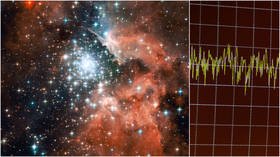Long-distance calls? Scientists uncover repeating ‘157-day pattern’ in mysterious intergalactic radio bursts

Astronomers have detected an “activity cycle” behind massive radio pulses emanating from a galaxy billions of light years away, shedding light on one of the great cosmic mysteries, which some suggest could be a sign of alien life.
Known as fast radio bursts (FRBs), the flashes of emissions were first noticed in 2007 and appear to originate from galaxies light-years away from Earth, but exactly what causes them still has scientists scratching their heads. The bursts are immensely powerful, giving off as much energy in the space of a few milliseconds as Earth’s sun does in a whole century.
While more than 100 FRBs have been observed since their discovery, most of them have been a one-off phenomenon, giving off only a single burst. But more recently, scientists have found that a small number of FRBs repeat, noticing regular patterns or “activity cycles” behind the enigmatic flashes.
Also on rt.com Astronomers studying ALIEN radio signals discover 8 NEW sources, one from nearby galaxyOne repeating burst – FRB 121102, emitted from a small dwarf galaxy about three billion light years from Earth – was watched for some five years by researchers at the Jodrell Bank Observatory in England, revealing a 157-day pattern. The burst appears to flare up for 90 days, only to die down for another 67 before repeating again, according to the findings, which were recently published in the Monthly Notices of the Royal Astronomical Society journal.
Though the researchers still can’t say what’s behind the cyclic activity, a number of explanations have been put forward. Some suggest the pulses are caused by the ‘wobble’ of a rotating magnetar – or a highly magnetized neutron star – while others posit they are linked to the orbital motions of a binary star system.
Lacking a definitive natural explanation for the mystery bursts, in 2017 researchers at the Harvard-Smithsonian Center for Astrophysics decided to explore unnatural causes, conducting a study theorizing that a massive solar-powered alien radio transmitter may be sending off the bursts in order to power “interstellar light sails.” They found that such a feat would be technically possible, but would require a solar panel with an area twice the size of Earth, putting it far beyond mankind’s current abilities. Though the scientists acknowledged the work was highly speculative, they nonetheless said it was “worth contemplating” an “artificial origin” for the radio bursts, which continue to baffle astronomers.
Also on rt.com Fast radio bursts: What are these ‘insanely powerful,’ unexplained signals from space?Like this story? Share it with a friend!













